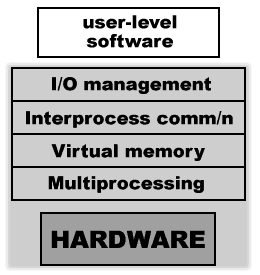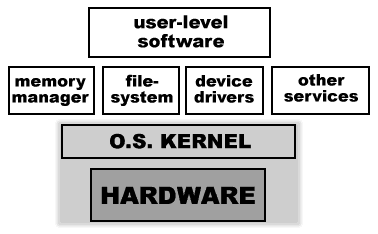operating system structures
(the unholy trinity)
(section 1.4)
Monolithic
 e.g. Windows 3.1, UNIX
e.g. Windows 3.1, UNIX
Like a big, black, shiny box. External interface, but no externally-visible
structure. Calls to OS typically through trap instruction.
- advantages: fine for few API calls, simple, easy to implement &
write (OS single linked program), efficient to implement.
- disadvantages: difficult to modify (must recompile kernel), unwieldy
if there's lots of functionality, all OS code must be trusted
Layered
 e.g. MULTICS
e.g. MULTICS
Like an onion-skinned monolithic system. Innermost layer provides essential
OS services (like process-scheduling & interrupt-handling); each additional
outer layer provides a higher-level VM to the layer above; each additional
layer is less 'trusted' (trust the layer below, but mistrust the layer
above). Typically uses hardware assistance to define & enforce layer
boundaries.
- advantages: more modular than monolithic, possibly more robust
- disadvantages: calls between multiple layers may incur overheads,
inflexible in terms of inserting additional layers and adding/removing features
(like device drivers) to/from a layer. Layer structure is fixed. Need special
hardware to enforce layer boundries.
Client-server (microkernel)
 e.g. Plan 9, Mach
e.g. Plan 9, Mach
More commonly known nowadays as a 'microkernel' architecture.
Single, small kernel provides only fundamental services, while federation
of reasonably independent processes provide all remaining OS services. For example, in operating systems based on the Mach kernel, even memory management is handled by non-kernel code.
Most of the OS runs in 'user mode' with no special privileges (though
certain services may require special privileges in order to get their work
done).
- advantages: easier to add and change modules. Modules are easier to
develop, and robust (because they may be protected from each other). Kernel can be very small and
efficient. Modules need not be on same machine. Can accommodate much larger
APIs (because it's broken up into modules).
- disadvantages: more sophisticated; probably needs more modern computers.
OS structure visible to programs (good or bad); requires a more sophisticated
security model to allow modules to provide services without stomping all
over each other.
OS designers strive to reduce the size of the kernel, and what is in the kernel.
It needs to provide only the most essential OS services: a framework for the other OS services to do their job and to communicate with each other.
what needs to be in a (micro)kernel?
-
process dispatcher/scheduler
-
interrupt handler
-
(perhaps low-level device-handling)
-
process communication
Reality check
In reality, nobody builds monolithic OSs any more. Layered systems offer
too much complexity for too little gain. Most modern OSs have (or claim to have) a modular,
object-oriented microkernel architecture. This structure has all the good points of the older two approaches: kernel is monolithic---simple, small, efficient---and 'layers' emerge from the way that higher-level modules use lower-level services.
last updated 29 April 1997
 e.g. Windows 3.1, UNIX
e.g. Windows 3.1, UNIX
 e.g. MULTICS
e.g. MULTICS
 e.g. Plan 9, Mach
e.g. Plan 9, Mach